Exam 2 Solutions: Exploring Contemporary Issues in Accounting
VerifiedAdded on 2023/06/14
|9
|2219
|190
Quiz and Exam
AI Summary
This document presents solutions to an exam focused on contemporary issues in accounting. It covers topics such as earning management techniques (cookie jar reserves, big bath accounting, revenue recognition), cultural differences impacting accounting practices, the differences between rule-based and principle-based approaches to corporate governance, and how bonus plans can mitigate agency problems. It also discusses positive accounting theory, corporate social and environmental reporting, international accounting harmonization and convergence, and the distinction between capital market research and behavioral accounting research. Further, the solutions address the triple bottom line concept (profit, people, planet), the differences between positive and normative accounting theories, and the conceptual framework versus accounting standards, referencing relevant academic sources and online materials. This resource is designed to aid students in understanding and mastering these complex accounting concepts.
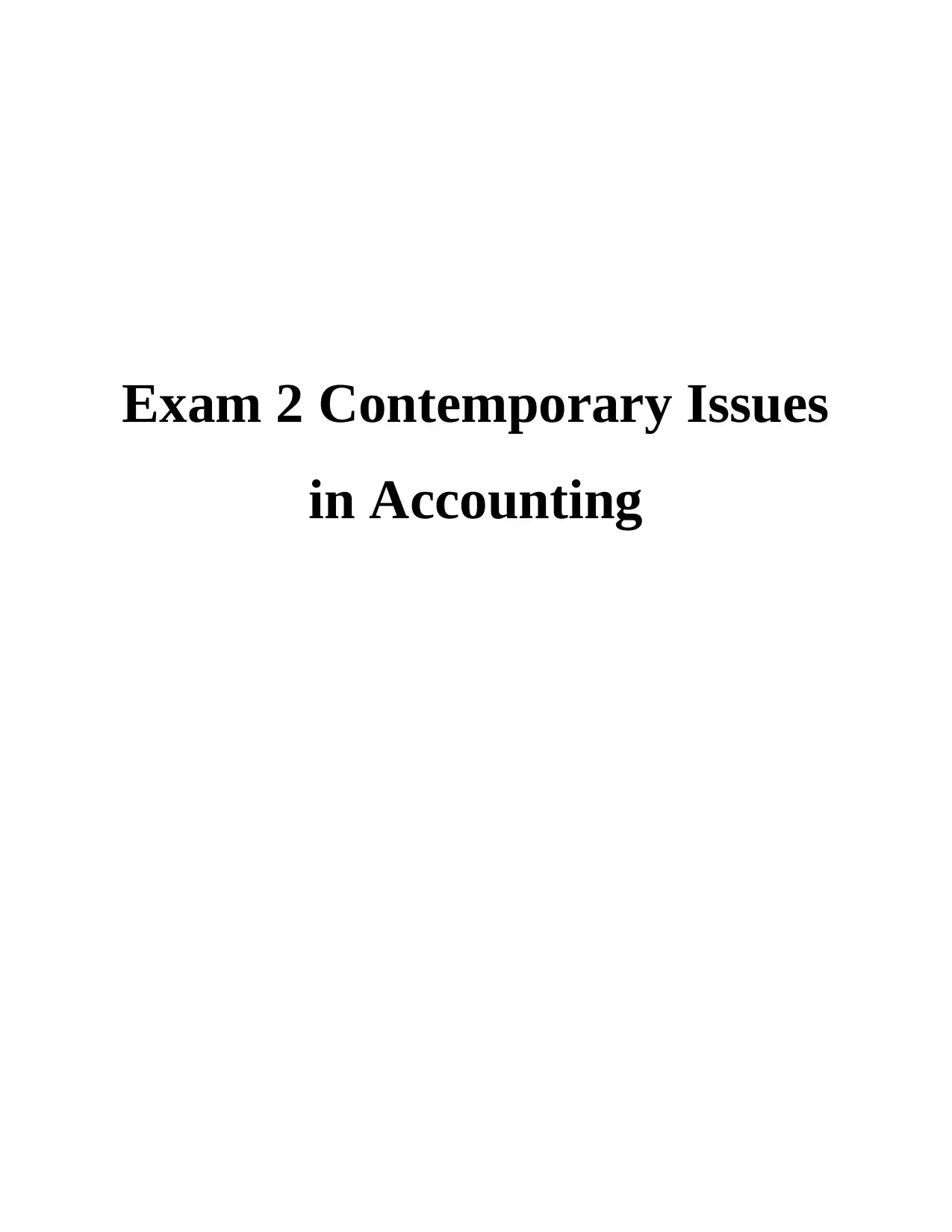
Exam 2 Contemporary Issues
in Accounting
in Accounting
Paraphrase This Document
Need a fresh take? Get an instant paraphrase of this document with our AI Paraphraser
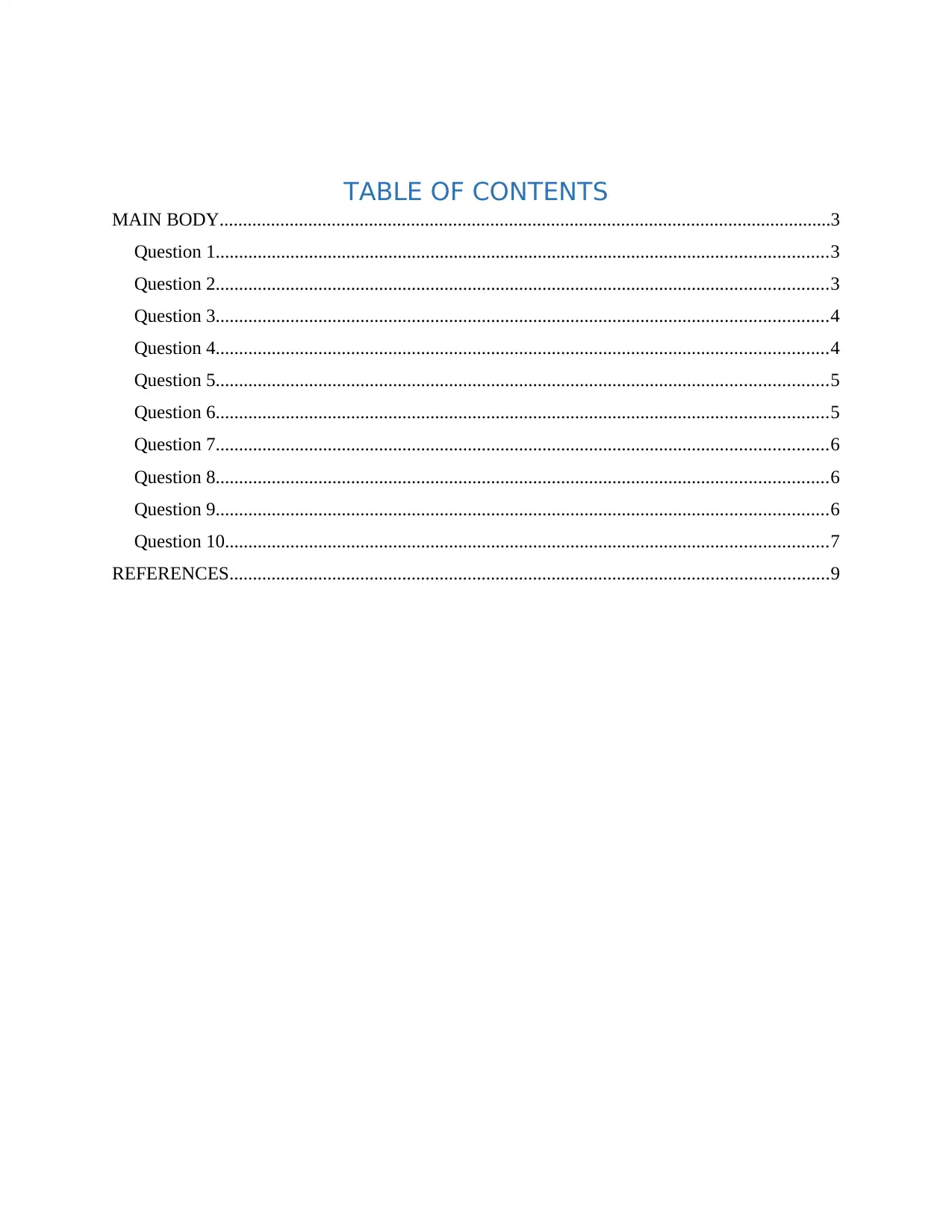
TABLE OF CONTENTS
MAIN BODY...................................................................................................................................3
Question 1...................................................................................................................................3
Question 2...................................................................................................................................3
Question 3...................................................................................................................................4
Question 4...................................................................................................................................4
Question 5...................................................................................................................................5
Question 6...................................................................................................................................5
Question 7...................................................................................................................................6
Question 8...................................................................................................................................6
Question 9...................................................................................................................................6
Question 10.................................................................................................................................7
REFERENCES................................................................................................................................9
MAIN BODY...................................................................................................................................3
Question 1...................................................................................................................................3
Question 2...................................................................................................................................3
Question 3...................................................................................................................................4
Question 4...................................................................................................................................4
Question 5...................................................................................................................................5
Question 6...................................................................................................................................5
Question 7...................................................................................................................................6
Question 8...................................................................................................................................6
Question 9...................................................................................................................................6
Question 10.................................................................................................................................7
REFERENCES................................................................................................................................9
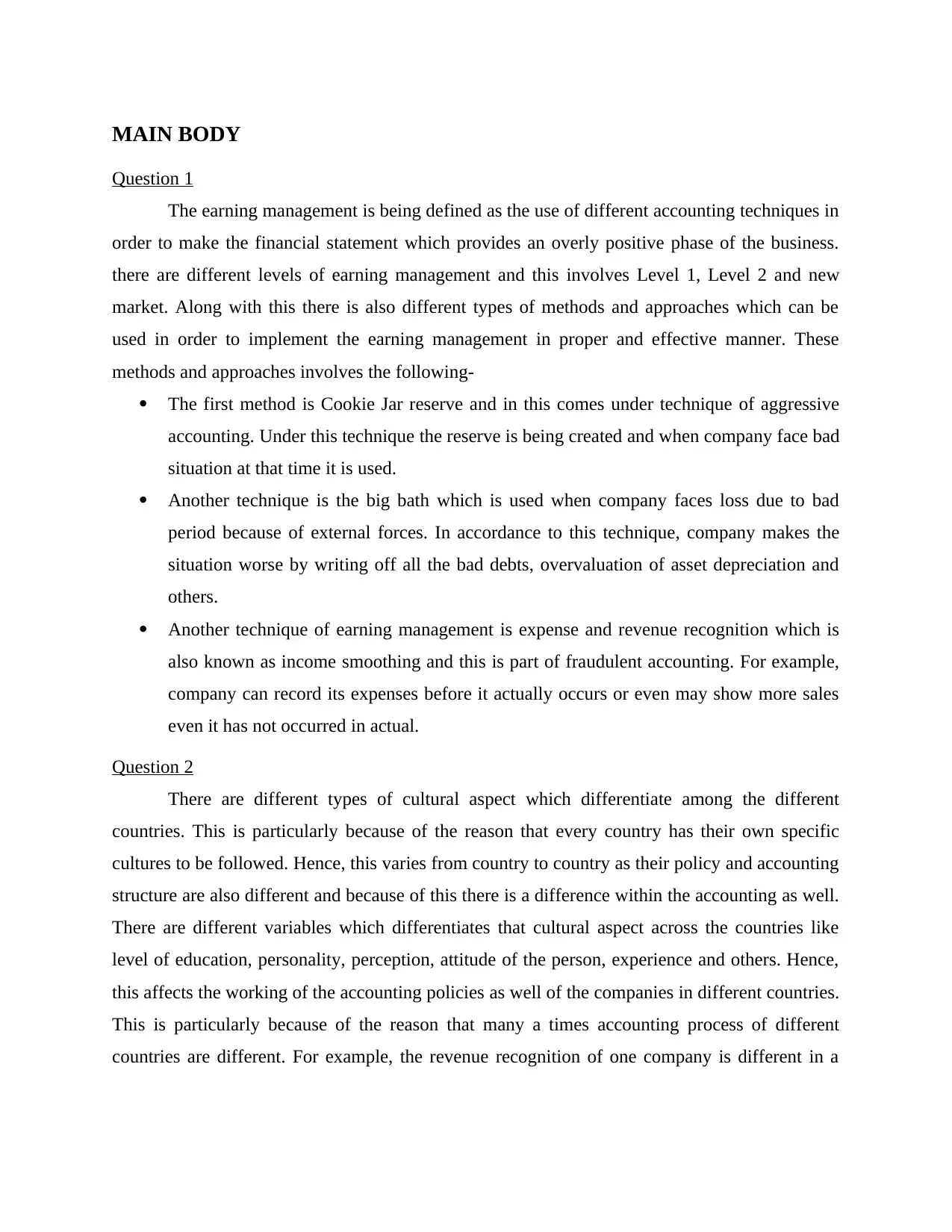
MAIN BODY
Question 1
The earning management is being defined as the use of different accounting techniques in
order to make the financial statement which provides an overly positive phase of the business.
there are different levels of earning management and this involves Level 1, Level 2 and new
market. Along with this there is also different types of methods and approaches which can be
used in order to implement the earning management in proper and effective manner. These
methods and approaches involves the following-
The first method is Cookie Jar reserve and in this comes under technique of aggressive
accounting. Under this technique the reserve is being created and when company face bad
situation at that time it is used.
Another technique is the big bath which is used when company faces loss due to bad
period because of external forces. In accordance to this technique, company makes the
situation worse by writing off all the bad debts, overvaluation of asset depreciation and
others.
Another technique of earning management is expense and revenue recognition which is
also known as income smoothing and this is part of fraudulent accounting. For example,
company can record its expenses before it actually occurs or even may show more sales
even it has not occurred in actual.
Question 2
There are different types of cultural aspect which differentiate among the different
countries. This is particularly because of the reason that every country has their own specific
cultures to be followed. Hence, this varies from country to country as their policy and accounting
structure are also different and because of this there is a difference within the accounting as well.
There are different variables which differentiates that cultural aspect across the countries like
level of education, personality, perception, attitude of the person, experience and others. Hence,
this affects the working of the accounting policies as well of the companies in different countries.
This is particularly because of the reason that many a times accounting process of different
countries are different. For example, the revenue recognition of one company is different in a
Question 1
The earning management is being defined as the use of different accounting techniques in
order to make the financial statement which provides an overly positive phase of the business.
there are different levels of earning management and this involves Level 1, Level 2 and new
market. Along with this there is also different types of methods and approaches which can be
used in order to implement the earning management in proper and effective manner. These
methods and approaches involves the following-
The first method is Cookie Jar reserve and in this comes under technique of aggressive
accounting. Under this technique the reserve is being created and when company face bad
situation at that time it is used.
Another technique is the big bath which is used when company faces loss due to bad
period because of external forces. In accordance to this technique, company makes the
situation worse by writing off all the bad debts, overvaluation of asset depreciation and
others.
Another technique of earning management is expense and revenue recognition which is
also known as income smoothing and this is part of fraudulent accounting. For example,
company can record its expenses before it actually occurs or even may show more sales
even it has not occurred in actual.
Question 2
There are different types of cultural aspect which differentiate among the different
countries. This is particularly because of the reason that every country has their own specific
cultures to be followed. Hence, this varies from country to country as their policy and accounting
structure are also different and because of this there is a difference within the accounting as well.
There are different variables which differentiates that cultural aspect across the countries like
level of education, personality, perception, attitude of the person, experience and others. Hence,
this affects the working of the accounting policies as well of the companies in different countries.
This is particularly because of the reason that many a times accounting process of different
countries are different. For example, the revenue recognition of one company is different in a
⊘ This is a preview!⊘
Do you want full access?
Subscribe today to unlock all pages.

Trusted by 1+ million students worldwide
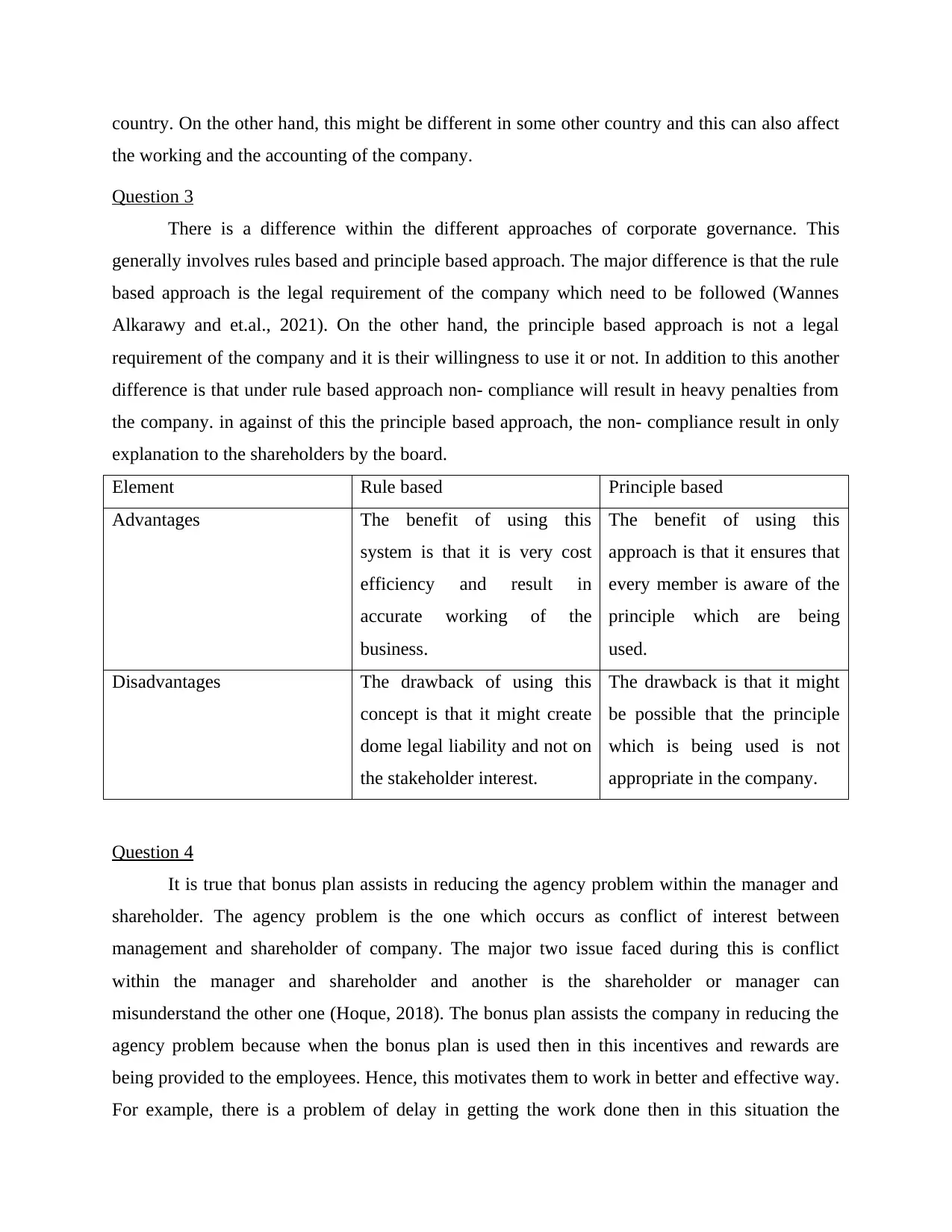
country. On the other hand, this might be different in some other country and this can also affect
the working and the accounting of the company.
Question 3
There is a difference within the different approaches of corporate governance. This
generally involves rules based and principle based approach. The major difference is that the rule
based approach is the legal requirement of the company which need to be followed (Wannes
Alkarawy and et.al., 2021). On the other hand, the principle based approach is not a legal
requirement of the company and it is their willingness to use it or not. In addition to this another
difference is that under rule based approach non- compliance will result in heavy penalties from
the company. in against of this the principle based approach, the non- compliance result in only
explanation to the shareholders by the board.
Element Rule based Principle based
Advantages The benefit of using this
system is that it is very cost
efficiency and result in
accurate working of the
business.
The benefit of using this
approach is that it ensures that
every member is aware of the
principle which are being
used.
Disadvantages The drawback of using this
concept is that it might create
dome legal liability and not on
the stakeholder interest.
The drawback is that it might
be possible that the principle
which is being used is not
appropriate in the company.
Question 4
It is true that bonus plan assists in reducing the agency problem within the manager and
shareholder. The agency problem is the one which occurs as conflict of interest between
management and shareholder of company. The major two issue faced during this is conflict
within the manager and shareholder and another is the shareholder or manager can
misunderstand the other one (Hoque, 2018). The bonus plan assists the company in reducing the
agency problem because when the bonus plan is used then in this incentives and rewards are
being provided to the employees. Hence, this motivates them to work in better and effective way.
For example, there is a problem of delay in getting the work done then in this situation the
the working and the accounting of the company.
Question 3
There is a difference within the different approaches of corporate governance. This
generally involves rules based and principle based approach. The major difference is that the rule
based approach is the legal requirement of the company which need to be followed (Wannes
Alkarawy and et.al., 2021). On the other hand, the principle based approach is not a legal
requirement of the company and it is their willingness to use it or not. In addition to this another
difference is that under rule based approach non- compliance will result in heavy penalties from
the company. in against of this the principle based approach, the non- compliance result in only
explanation to the shareholders by the board.
Element Rule based Principle based
Advantages The benefit of using this
system is that it is very cost
efficiency and result in
accurate working of the
business.
The benefit of using this
approach is that it ensures that
every member is aware of the
principle which are being
used.
Disadvantages The drawback of using this
concept is that it might create
dome legal liability and not on
the stakeholder interest.
The drawback is that it might
be possible that the principle
which is being used is not
appropriate in the company.
Question 4
It is true that bonus plan assists in reducing the agency problem within the manager and
shareholder. The agency problem is the one which occurs as conflict of interest between
management and shareholder of company. The major two issue faced during this is conflict
within the manager and shareholder and another is the shareholder or manager can
misunderstand the other one (Hoque, 2018). The bonus plan assists the company in reducing the
agency problem because when the bonus plan is used then in this incentives and rewards are
being provided to the employees. Hence, this motivates them to work in better and effective way.
For example, there is a problem of delay in getting the work done then in this situation the
Paraphrase This Document
Need a fresh take? Get an instant paraphrase of this document with our AI Paraphraser
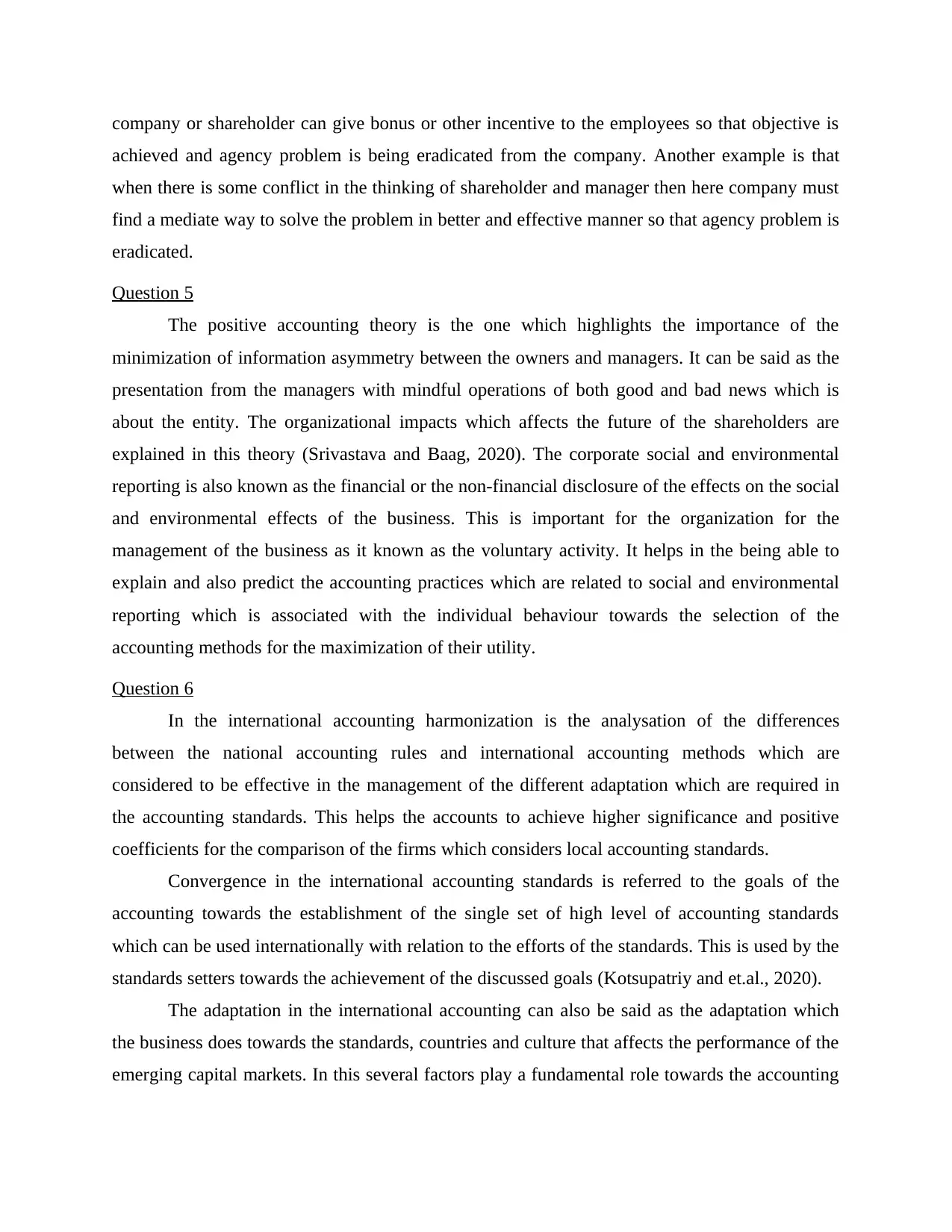
company or shareholder can give bonus or other incentive to the employees so that objective is
achieved and agency problem is being eradicated from the company. Another example is that
when there is some conflict in the thinking of shareholder and manager then here company must
find a mediate way to solve the problem in better and effective manner so that agency problem is
eradicated.
Question 5
The positive accounting theory is the one which highlights the importance of the
minimization of information asymmetry between the owners and managers. It can be said as the
presentation from the managers with mindful operations of both good and bad news which is
about the entity. The organizational impacts which affects the future of the shareholders are
explained in this theory (Srivastava and Baag, 2020). The corporate social and environmental
reporting is also known as the financial or the non-financial disclosure of the effects on the social
and environmental effects of the business. This is important for the organization for the
management of the business as it known as the voluntary activity. It helps in the being able to
explain and also predict the accounting practices which are related to social and environmental
reporting which is associated with the individual behaviour towards the selection of the
accounting methods for the maximization of their utility.
Question 6
In the international accounting harmonization is the analysation of the differences
between the national accounting rules and international accounting methods which are
considered to be effective in the management of the different adaptation which are required in
the accounting standards. This helps the accounts to achieve higher significance and positive
coefficients for the comparison of the firms which considers local accounting standards.
Convergence in the international accounting standards is referred to the goals of the
accounting towards the establishment of the single set of high level of accounting standards
which can be used internationally with relation to the efforts of the standards. This is used by the
standards setters towards the achievement of the discussed goals (Kotsupatriy and et.al., 2020).
The adaptation in the international accounting can also be said as the adaptation which
the business does towards the standards, countries and culture that affects the performance of the
emerging capital markets. In this several factors play a fundamental role towards the accounting
achieved and agency problem is being eradicated from the company. Another example is that
when there is some conflict in the thinking of shareholder and manager then here company must
find a mediate way to solve the problem in better and effective manner so that agency problem is
eradicated.
Question 5
The positive accounting theory is the one which highlights the importance of the
minimization of information asymmetry between the owners and managers. It can be said as the
presentation from the managers with mindful operations of both good and bad news which is
about the entity. The organizational impacts which affects the future of the shareholders are
explained in this theory (Srivastava and Baag, 2020). The corporate social and environmental
reporting is also known as the financial or the non-financial disclosure of the effects on the social
and environmental effects of the business. This is important for the organization for the
management of the business as it known as the voluntary activity. It helps in the being able to
explain and also predict the accounting practices which are related to social and environmental
reporting which is associated with the individual behaviour towards the selection of the
accounting methods for the maximization of their utility.
Question 6
In the international accounting harmonization is the analysation of the differences
between the national accounting rules and international accounting methods which are
considered to be effective in the management of the different adaptation which are required in
the accounting standards. This helps the accounts to achieve higher significance and positive
coefficients for the comparison of the firms which considers local accounting standards.
Convergence in the international accounting standards is referred to the goals of the
accounting towards the establishment of the single set of high level of accounting standards
which can be used internationally with relation to the efforts of the standards. This is used by the
standards setters towards the achievement of the discussed goals (Kotsupatriy and et.al., 2020).
The adaptation in the international accounting can also be said as the adaptation which
the business does towards the standards, countries and culture that affects the performance of the
emerging capital markets. In this several factors play a fundamental role towards the accounting
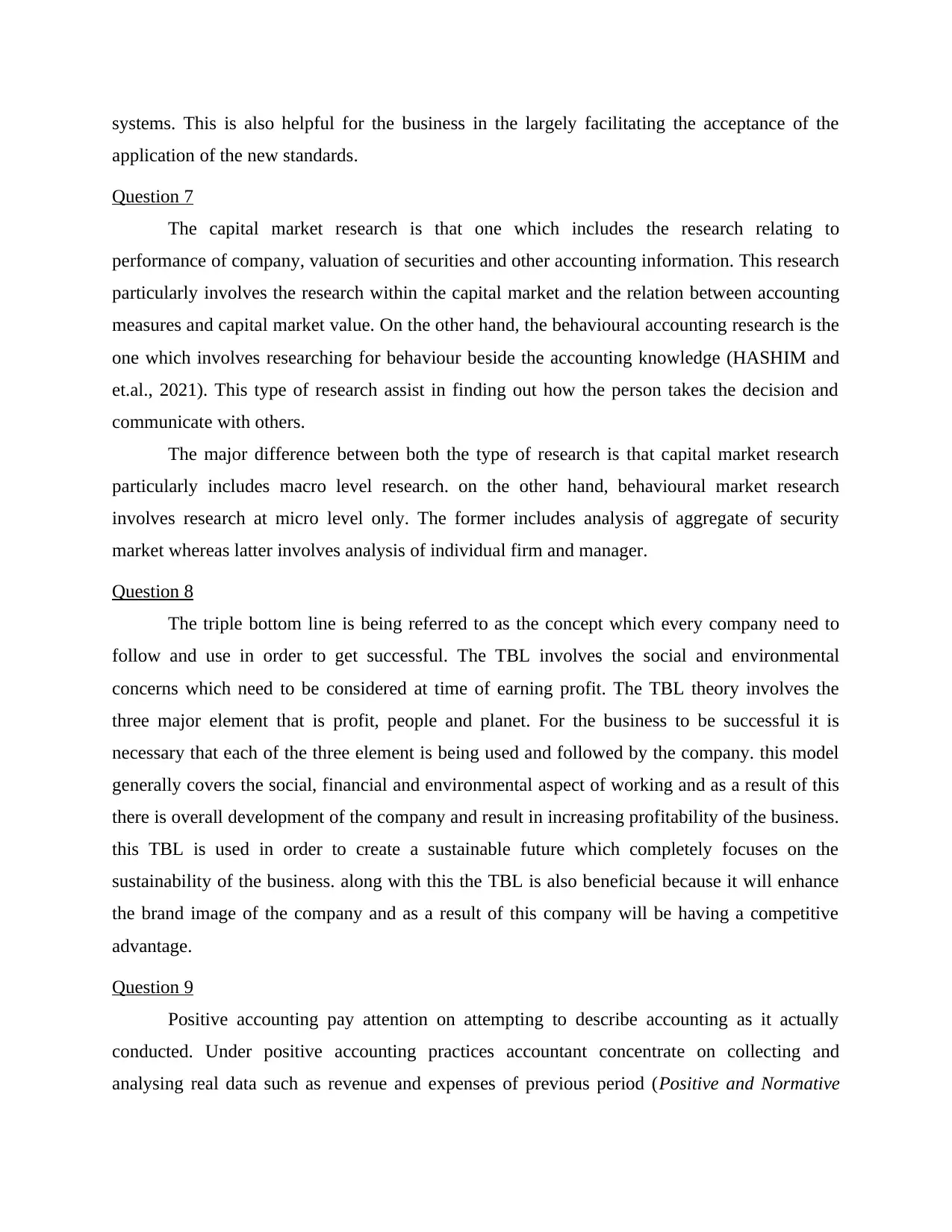
systems. This is also helpful for the business in the largely facilitating the acceptance of the
application of the new standards.
Question 7
The capital market research is that one which includes the research relating to
performance of company, valuation of securities and other accounting information. This research
particularly involves the research within the capital market and the relation between accounting
measures and capital market value. On the other hand, the behavioural accounting research is the
one which involves researching for behaviour beside the accounting knowledge (HASHIM and
et.al., 2021). This type of research assist in finding out how the person takes the decision and
communicate with others.
The major difference between both the type of research is that capital market research
particularly includes macro level research. on the other hand, behavioural market research
involves research at micro level only. The former includes analysis of aggregate of security
market whereas latter involves analysis of individual firm and manager.
Question 8
The triple bottom line is being referred to as the concept which every company need to
follow and use in order to get successful. The TBL involves the social and environmental
concerns which need to be considered at time of earning profit. The TBL theory involves the
three major element that is profit, people and planet. For the business to be successful it is
necessary that each of the three element is being used and followed by the company. this model
generally covers the social, financial and environmental aspect of working and as a result of this
there is overall development of the company and result in increasing profitability of the business.
this TBL is used in order to create a sustainable future which completely focuses on the
sustainability of the business. along with this the TBL is also beneficial because it will enhance
the brand image of the company and as a result of this company will be having a competitive
advantage.
Question 9
Positive accounting pay attention on attempting to describe accounting as it actually
conducted. Under positive accounting practices accountant concentrate on collecting and
analysing real data such as revenue and expenses of previous period (Positive and Normative
application of the new standards.
Question 7
The capital market research is that one which includes the research relating to
performance of company, valuation of securities and other accounting information. This research
particularly involves the research within the capital market and the relation between accounting
measures and capital market value. On the other hand, the behavioural accounting research is the
one which involves researching for behaviour beside the accounting knowledge (HASHIM and
et.al., 2021). This type of research assist in finding out how the person takes the decision and
communicate with others.
The major difference between both the type of research is that capital market research
particularly includes macro level research. on the other hand, behavioural market research
involves research at micro level only. The former includes analysis of aggregate of security
market whereas latter involves analysis of individual firm and manager.
Question 8
The triple bottom line is being referred to as the concept which every company need to
follow and use in order to get successful. The TBL involves the social and environmental
concerns which need to be considered at time of earning profit. The TBL theory involves the
three major element that is profit, people and planet. For the business to be successful it is
necessary that each of the three element is being used and followed by the company. this model
generally covers the social, financial and environmental aspect of working and as a result of this
there is overall development of the company and result in increasing profitability of the business.
this TBL is used in order to create a sustainable future which completely focuses on the
sustainability of the business. along with this the TBL is also beneficial because it will enhance
the brand image of the company and as a result of this company will be having a competitive
advantage.
Question 9
Positive accounting pay attention on attempting to describe accounting as it actually
conducted. Under positive accounting practices accountant concentrate on collecting and
analysing real data such as revenue and expenses of previous period (Positive and Normative
⊘ This is a preview!⊘
Do you want full access?
Subscribe today to unlock all pages.

Trusted by 1+ million students worldwide

Accounting – What’s the Difference? 2022). This type of theory largely focuses on striving the
accounting for objectivity and having subjective parameters for having making assumptions. It
pays attention on analysing the economic statistics hand data in turn relevant information to
manage accounting practice can become possible. There are several companies which highlights
the positive accounting theory into its processes. On the other side, normative accounting theory
is related with focusing on the accounting as it should be done. It aims to describe accounting
that should be done via using subjective morality derived. This is basically based on the
observation that involves figuring out what principals should be applied to each situation by
offering number of choices. Accounting practice is as form of valuing he judgement that can
introduce morality into accounting. It helps investors or company to obtain the information
regarding the future course of action by involving future events rather than data. On the basis of
this it can be interpreted that these both are different.
Question 10
Conceptual framework is related with specific definitions for discussion of accounting
problems. It is the financial accounting theory that is related with body of sets standards to test
problems that are practical. This allows to get the information as plays role in issues that
concern financial reporting (Difference Between Conceptual Frameworks and Accounting
Standards, 2022). This assist the financial auditors and preparations for improving the
implementation of the IFRS regulations which is feature of the logical system that considered to
be versatile. On the other side, accounting standard is related h with defining specific financial
statements' credibility & reliability. It consists collection of public standards for identifying,
measuring, presenting h and disclosing facts contained in an n organization's financial statement.
These are rules that are stringent and not compatible with different financial accounting
perspective. There are fur main qualitative characteristics continue to be timeliness
understandability, verifiability and comparability. This is considered to be elements h of
financial statements that are recognition n and measurement of elements so that accurate
understanding can be obtained.
accounting for objectivity and having subjective parameters for having making assumptions. It
pays attention on analysing the economic statistics hand data in turn relevant information to
manage accounting practice can become possible. There are several companies which highlights
the positive accounting theory into its processes. On the other side, normative accounting theory
is related with focusing on the accounting as it should be done. It aims to describe accounting
that should be done via using subjective morality derived. This is basically based on the
observation that involves figuring out what principals should be applied to each situation by
offering number of choices. Accounting practice is as form of valuing he judgement that can
introduce morality into accounting. It helps investors or company to obtain the information
regarding the future course of action by involving future events rather than data. On the basis of
this it can be interpreted that these both are different.
Question 10
Conceptual framework is related with specific definitions for discussion of accounting
problems. It is the financial accounting theory that is related with body of sets standards to test
problems that are practical. This allows to get the information as plays role in issues that
concern financial reporting (Difference Between Conceptual Frameworks and Accounting
Standards, 2022). This assist the financial auditors and preparations for improving the
implementation of the IFRS regulations which is feature of the logical system that considered to
be versatile. On the other side, accounting standard is related h with defining specific financial
statements' credibility & reliability. It consists collection of public standards for identifying,
measuring, presenting h and disclosing facts contained in an n organization's financial statement.
These are rules that are stringent and not compatible with different financial accounting
perspective. There are fur main qualitative characteristics continue to be timeliness
understandability, verifiability and comparability. This is considered to be elements h of
financial statements that are recognition n and measurement of elements so that accurate
understanding can be obtained.
Paraphrase This Document
Need a fresh take? Get an instant paraphrase of this document with our AI Paraphraser

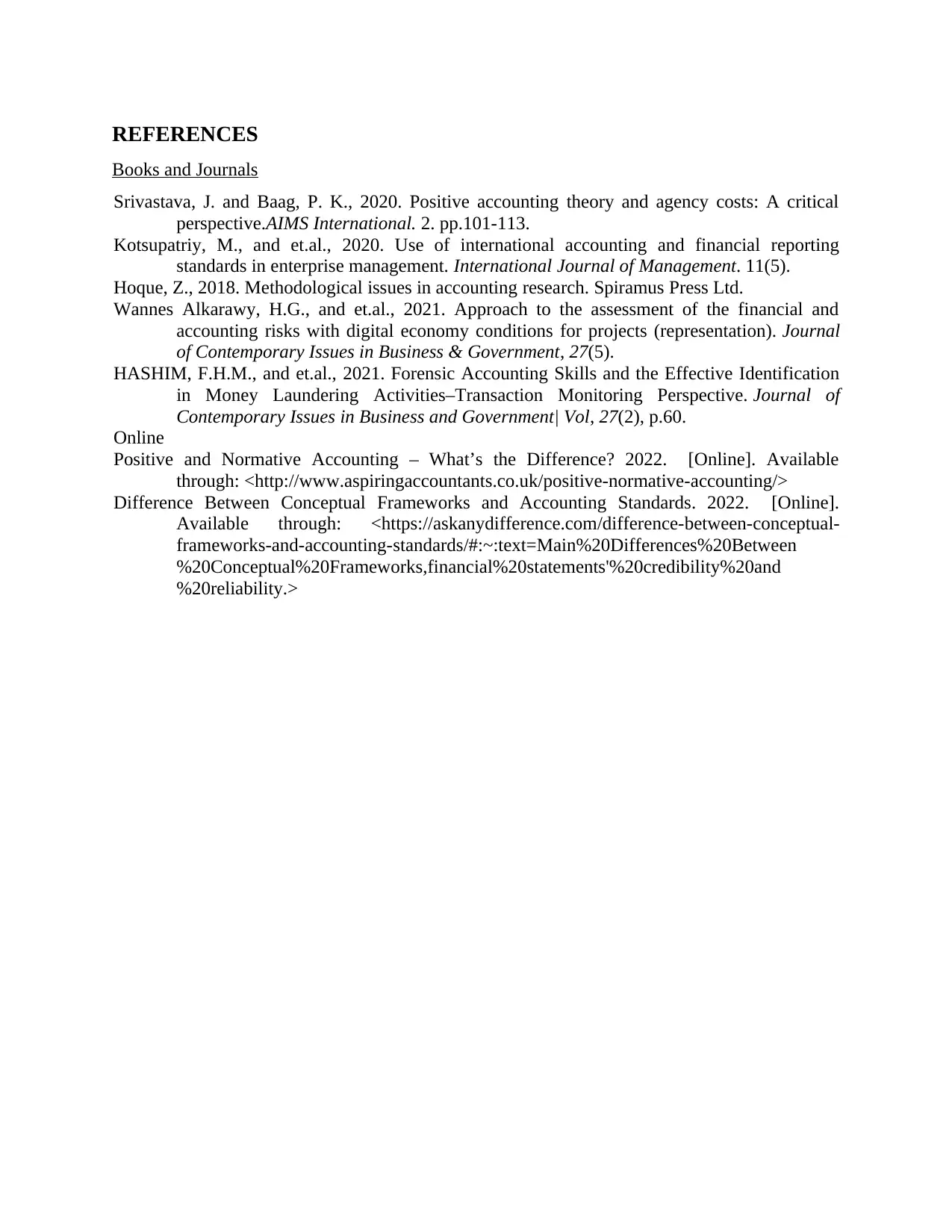
REFERENCES
Books and Journals
Srivastava, J. and Baag, P. K., 2020. Positive accounting theory and agency costs: A critical
perspective.AIMS International. 2. pp.101-113.
Kotsupatriy, M., and et.al., 2020. Use of international accounting and financial reporting
standards in enterprise management. International Journal of Management. 11(5).
Hoque, Z., 2018. Methodological issues in accounting research. Spiramus Press Ltd.
Wannes Alkarawy, H.G., and et.al., 2021. Approach to the assessment of the financial and
accounting risks with digital economy conditions for projects (representation). Journal
of Contemporary Issues in Business & Government, 27(5).
HASHIM, F.H.M., and et.al., 2021. Forensic Accounting Skills and the Effective Identification
in Money Laundering Activities–Transaction Monitoring Perspective. Journal of
Contemporary Issues in Business and Government| Vol, 27(2), p.60.
Online
Positive and Normative Accounting – What’s the Difference? 2022. [Online]. Available
through: <http://www.aspiringaccountants.co.uk/positive-normative-accounting/>
Difference Between Conceptual Frameworks and Accounting Standards. 2022. [Online].
Available through: <https://askanydifference.com/difference-between-conceptual-
frameworks-and-accounting-standards/#:~:text=Main%20Differences%20Between
%20Conceptual%20Frameworks,financial%20statements'%20credibility%20and
%20reliability.>
Books and Journals
Srivastava, J. and Baag, P. K., 2020. Positive accounting theory and agency costs: A critical
perspective.AIMS International. 2. pp.101-113.
Kotsupatriy, M., and et.al., 2020. Use of international accounting and financial reporting
standards in enterprise management. International Journal of Management. 11(5).
Hoque, Z., 2018. Methodological issues in accounting research. Spiramus Press Ltd.
Wannes Alkarawy, H.G., and et.al., 2021. Approach to the assessment of the financial and
accounting risks with digital economy conditions for projects (representation). Journal
of Contemporary Issues in Business & Government, 27(5).
HASHIM, F.H.M., and et.al., 2021. Forensic Accounting Skills and the Effective Identification
in Money Laundering Activities–Transaction Monitoring Perspective. Journal of
Contemporary Issues in Business and Government| Vol, 27(2), p.60.
Online
Positive and Normative Accounting – What’s the Difference? 2022. [Online]. Available
through: <http://www.aspiringaccountants.co.uk/positive-normative-accounting/>
Difference Between Conceptual Frameworks and Accounting Standards. 2022. [Online].
Available through: <https://askanydifference.com/difference-between-conceptual-
frameworks-and-accounting-standards/#:~:text=Main%20Differences%20Between
%20Conceptual%20Frameworks,financial%20statements'%20credibility%20and
%20reliability.>
⊘ This is a preview!⊘
Do you want full access?
Subscribe today to unlock all pages.

Trusted by 1+ million students worldwide
1 out of 9
Related Documents
Your All-in-One AI-Powered Toolkit for Academic Success.
+13062052269
info@desklib.com
Available 24*7 on WhatsApp / Email
![[object Object]](/_next/static/media/star-bottom.7253800d.svg)
Unlock your academic potential
Copyright © 2020–2025 A2Z Services. All Rights Reserved. Developed and managed by ZUCOL.





